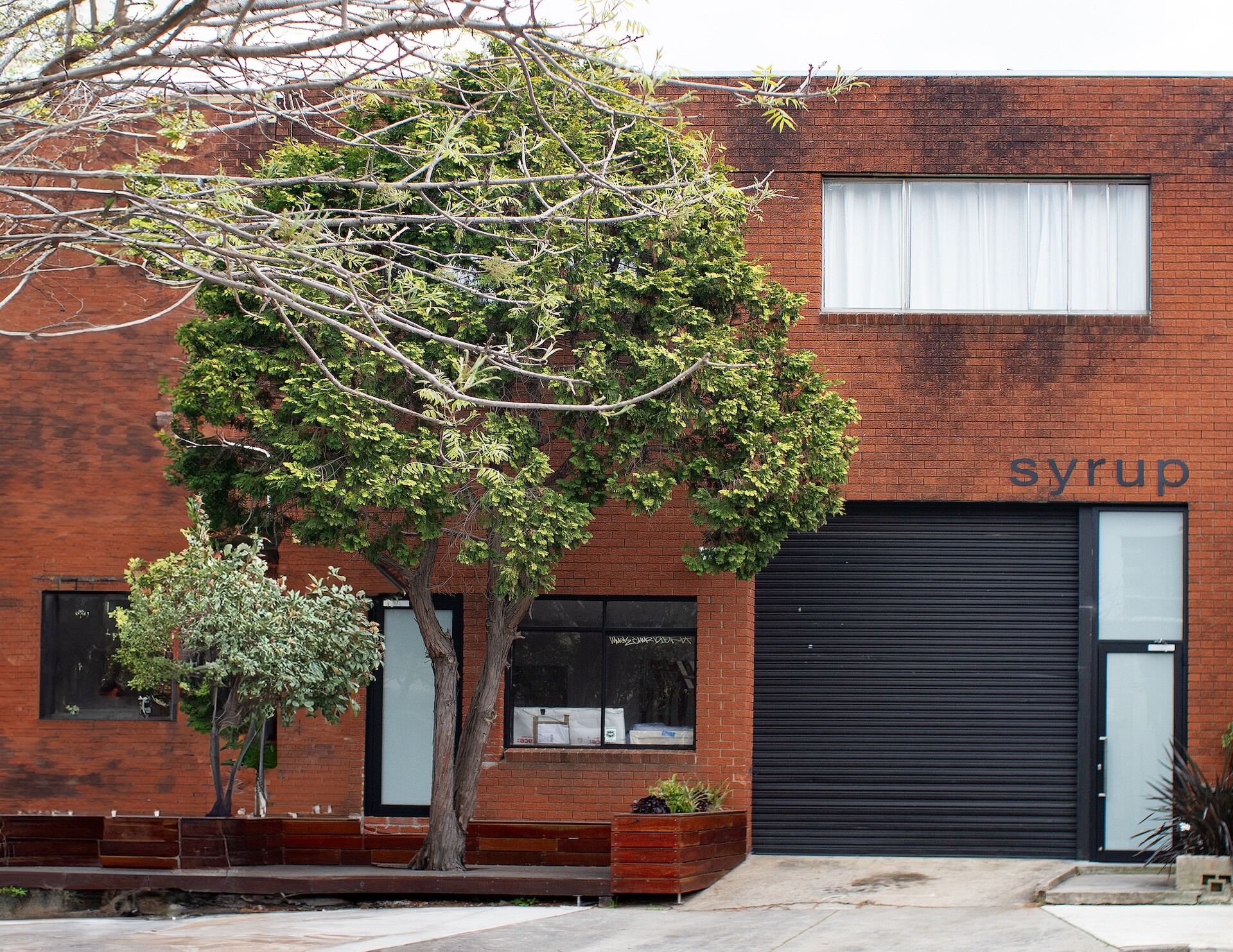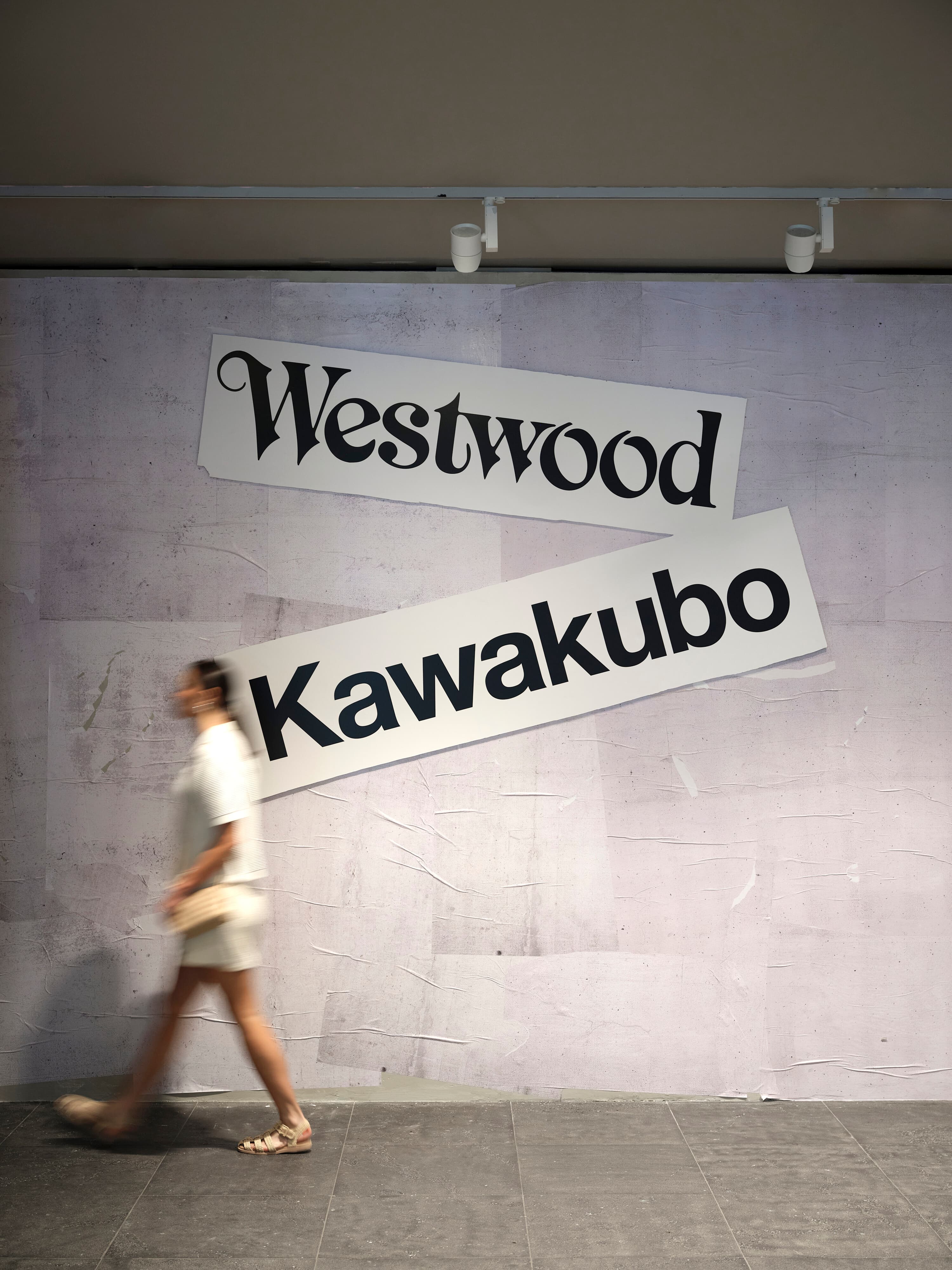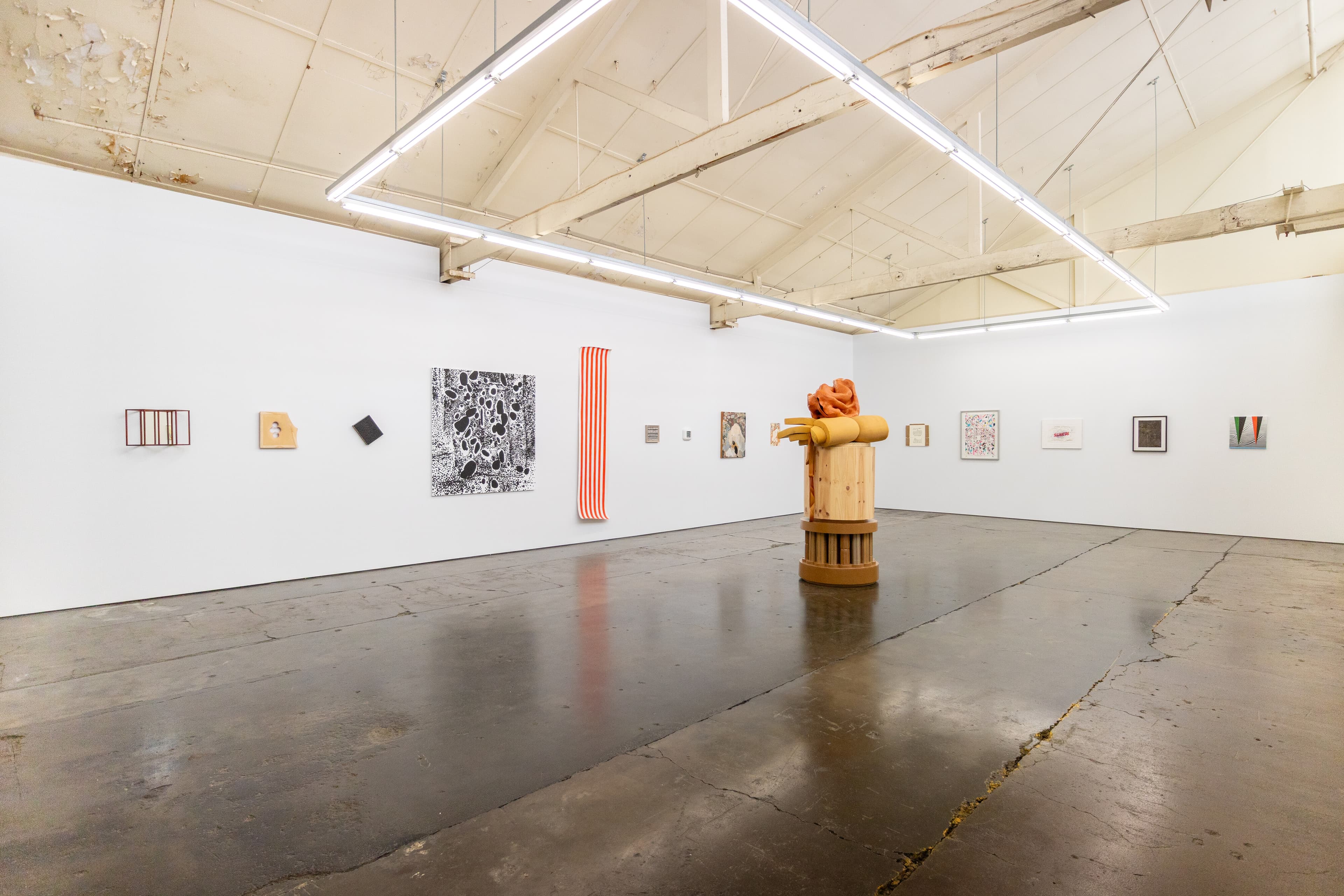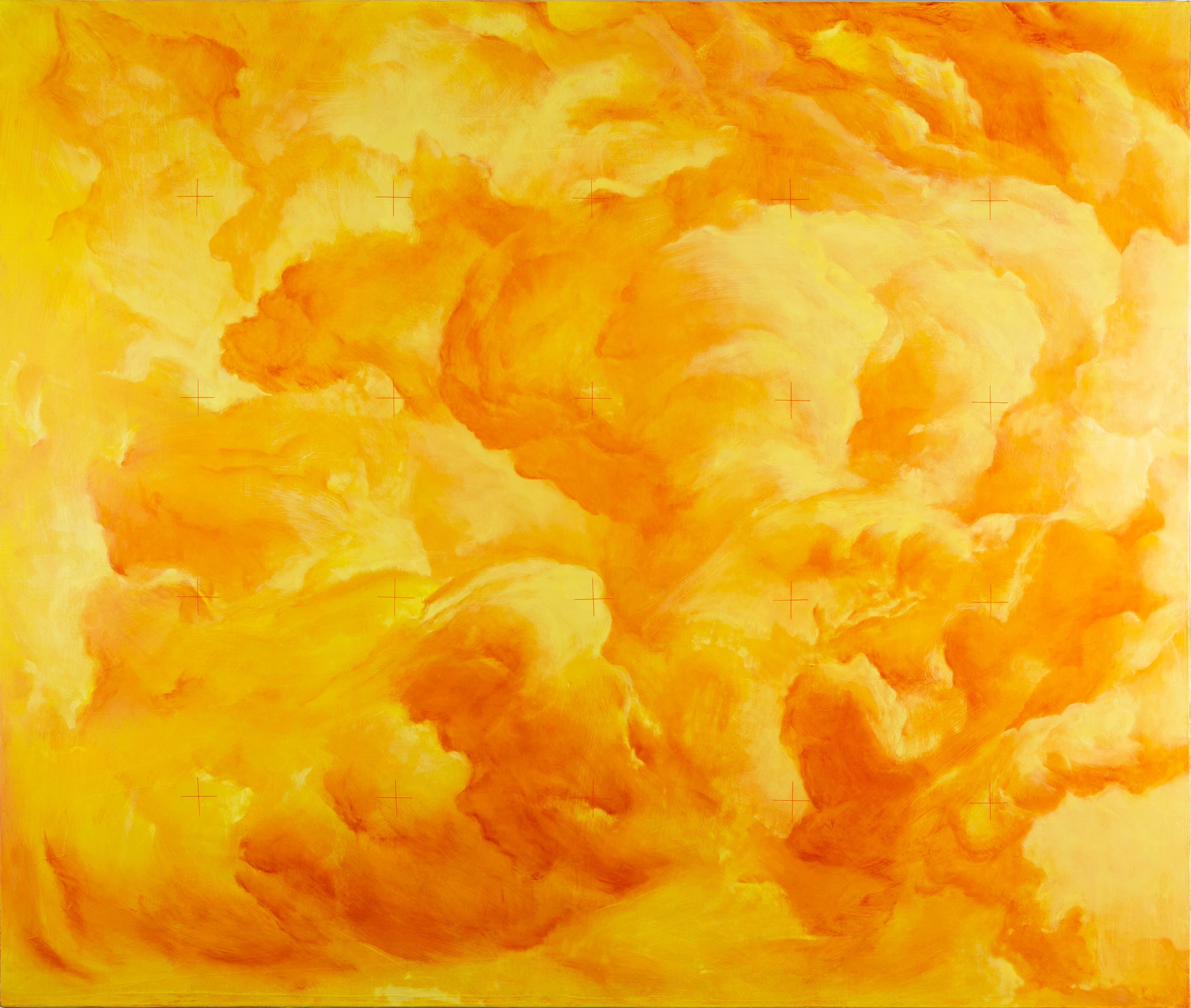Installation view of A tide is a very long wave, SYRUP. Photo: SYRUP.
A tide is a very long wave
June Miskell
The spherical ocean’s luminescence is a thing familiar, but our energies won’t respond to its call; they’re designed for the body’s penetration by salt, and the soft happiness that invades the spirit when water meets light.
— Etel Adnan, Sea and Fog, 2012
SYRUP opened in April, 2024. Located in the industrial warehouse and factory-lined pocket of Marrickville near Sydenham and Victoria Roads, the six-month old gallery is the newest kid on the block. SYRUP is the brainchild of co-directors and artists Carolyn McKenzie-Craig and Damian Dillon, who previously founded the one-room artist-run initiative Schmick Contemporary together in 2020. A stone’s throw away are the galleries Sydenham International, LAILA, and The Commercial. Like its fellow roller-doored art neighbours, SYRUP has an industrial edge. A bit less “schmick” than Schmick, with tenfold the amount of breathing space. At the entrance of the gallery is a mounted bicycle, exposed electrical conduits, and a packing crate that doubles as a display for the exhibition paraphernalia. On the day I visited SYRUP, hefty winds ruffled the foil insulation in the exposed roof, the roller door shuddered with each gust, and the intermittent roar of aeroplane exhaust reverberated through the space (the gallery is under the infamous flight path). The atmosphere whirled with a degree of turbulence, a constant ebb and flow.

Exterior of SYRUP, Marrickville. Photo: Damian Dillon, SYRUP.
A tide is a very long wave mirrors this state of motion. Curated by Sarah Hibbs, the exhibition presents work by artists Joshua Edward, Yvette James, Clara Joyce, Izabela Pluta, Salote Tawale, Shan Turner-Carroll, and a new poem by Anne-Marie Tu Whiu. As the exhibition title suggests, tidal systems are a central theme of the show. Undoubtedly, bodies of water (and thus, tides) have been a prevalent thematic across international and local contemporary art exhibitions in recent years. Think Water at QAGOMA (2019–20), or rīvus, the 23rd Biennale of Sydney (2022), and Re-Stor(y)ing Oceania at Ocean Space, Venice (2024), for example. As critical ocean literacy has grown under the conditions of climate crisis, so too have these exhibitions, which have variously grappled with the aesthetics and politics of water.
Although “the politics and lore of oceanspace,” according to Hibbs, is one current of the exhibition, it is not the only stream. A tide is a very long wave is perhaps more about distant attraction, liminality, longing, and return. The works in the exhibition encourage us to think “with” the tide, that is, the long-period waves that move through the ocean as a result of the gravitational forces exerted between the earth, moon, and sun. A tide is a very long wave, to my mind, is less “about” the literal tide; rather, it utilises the tide as its leitmotif. The tide is a method. After all, the tide is an errant and dynamic force.

Joshua Edward, Shadows move across her face I-V, 2024. Aluminium, glass, 250g sea salt, polylactic acid, sterling silver. Five plates, each 60 x 40 x 2.5cm. Photo: SYRUP.
Entering at the mouth of the exhibition, I gravitate towards a long stretcher-like aluminium frame raised slightly above the ground. Joshua Edward’s Shadows move across her face I-V (2024) is comprised of a series of five saltwater vitrines, each containing the now evaporated residue of 250 grams of sodium—“the same quantity as the average adult body,” Hibbs’s exhibition essay tells me. In these alchemical vitrines, the sodium deposits left behind resemble lunar regolith, forming irregularly pitted surfaces of highlands, maria, and craters. What appear to be varying lunarscapes also index distinct (human) bodies, a haunting or melancholic trace of what hitherto has ceased to exist. Meanwhile, the residue diffuses into a new form even as it loses hold of its previous.
There are other kinds of holds, too. Edward’s …Shadows move across her face…After: UNTITLED (NOTES ON THE DEATH OF A FRIEND, FROM THE AUTHOR) (2021, ie) (2024), intimately captures the artist and a friend embraced in a mid-orbital twirl against a New York cityscape. The tiny black and white photograph freezes an otherwise fleeting moment, memorialising the pair and their magnetic pull toward one another in a state of perpetuity. In another series of photographs, on the adjacent wall, titled Sun and Moon Walk 2, 3, and 4 (2015), Shan Turner-Carroll documents himself at various vantage points in a twenty-four-hour durational walking performance throughout New York. Holding a circular mirror angled in the direction of the sun and moon, the images record Turner-Carroll in this embodied encounter. In turn, crepuscular and lambent light is twice reflected: first, in the mirror and second, in the lens as the image is captured. For both Edward and Turner-Carroll, the “pull” of these transitory moments are registered into something palpable. We wish to grasp, even if momentarily, that which ultimately remains elusive and ephemeral.

Installation view of Shan Turner-Carroll, Sun and Moon Walk 2, 3, and 4, 2015. Series of photographic prints mounted on aluminium. Photo: Jessica Maurer.

Detail of Yvette James, As we pull the earth towards ourselves, 2024. Motor oil, steel, silver. 420 x 90 x 92cm. Courtesy of the artist.
A tide is a very long wave draws upon the tide as a metaphor to consider a suite of gravitational forces. The force between the moon and earth, between distant bodies or objects, and between different locations. In Yvette James’s As we pull the earth towards ourselves (2024), a 20L Penrite motor oil drum pours viscous honey-coloured oil down a split steel funnel fixed in the centre of the room. The work conveys a yearning tension between liquid and gravity as syrupy engine oil (itself a composite of algae and phytoplankton) gradually leaked from one end of the funnel to the next. Emphasis on gradually—I only saw two drops fall during my visit. With a similar vertical flow is Clara Joyce’s Water Vision Instrument (2023), which plays with gravity and light. The work, comprising a Perspex biconvex bowl half-full of water atop a steel frame, bends light as it travels through the water inside the sphere. The optical effect is a warped reflection of the surrounding environment. Fittingly, as I move around this satellite sculpture, the maelstrom compositions of Joyce’s nearby paintings Breathing and Chaos (2024) and Open Caustic (1) (2024) are picked up by the sphere, questioning the conditions of perception. This enquiry reappears—albeit, towards different ends—in Salote Tawale and Izabela Pluta’s works, as we will come to see.

Installation view of Clara Joyce Open Caustic (1), 2024 (left); Water Vision Instrument, 2023. Perspex, water, steel frame. (centre); and Breathing and Chaos, 2024 (right). Photo: SYRUP and Taya Corrigan.

Installation view of Shan Turner-Carroll, Pushing Rocks, 2024. Foam, plaster, acrylic paint, glass, found glasses, found glass, found sticks, video, projector. Dimensions variable. Photo: Jessica Maurer.
Gravitational force continues to be addressed in Pushing Rocks (2024) by Turner-Carroll. The installation assembles a polystyrene imitation boulder (host to numerous sculptural accoutrements and a moon-shaped screen) opposite an accompanying video projector (fixed to a structure composed of a cardboard aperture, a disfigured whipper snipper, sticks, and tape). The projected image materialises on the screen in the shape of a waning crescent. Throughout the video, various figures are documented as they enter and exit an Icelandic landscape. Separately, they attempt to use their weight to shift immovable rock formations, to no success. “The pull of a place, and its mass,” according to Hibbs. Yet, in this simultaneous “push” and “pull” encounter between human and non-human bodies, what Turner-Carroll’s work punctuates are precisely the invisible forces of gravity at hand. The rocks, ultimately, always remain steadied—a reminder of our futility.

Installation view of Izabela Pluta, Counterspace (The Pacific: visualisation of bottom of the pacific / relief of bottom south parts), 2021, silver gelatin photographs (contact negatives) (left); and Izabela Pluta, Counterspace (The Pacific: twilight schedule / sunset schedule), 2021, silver gelatin photographs (contact negatives) (right). Photo: Jessica Maurer.
Returning to perception, A tide is a very long wave considers how (in)visible forces inform and delimit our understanding of and relationship with the ocean. Case in point are two silver gelatin diptychs from Izabela Pluta’s Counterspace (2021) series: Counterspace (The Pacific: visualisation of bottom of the pacific / relief of bottom south parts) and Counterspace (The Pacific: twilight schedule / sunset schedule). Using source material from the Soviet-era 1974 Atlas Oceanov (Atlas of the Oceans), Pluta blurs pages of maps and charts to create a fusion image. In her manipulation, Pluta calls into question imperial and colonial systems of knowledge which have historically determined natural phenomena, forces, and entities (in this case, the Pacific Ocean). Indeed, Pluta fissures the authority of these universalising logics.
Caught in the reflection of Pluta’s contact negatives is the briny ocean-blue light of Salote Tawale’s video I don’t see colour (2021), which hangs within a window aperture on the back wall. Tawale’s work plays with our perception, too. The video has a disorienting and dreamlike effect, as Tawale has flipped the perspective of the image upside-down. It feels like we are simultaneously at the surface and the bottom of the ocean. Throughout the video, Tawale remains buoyant in the water, drifting gently with the tide that shifts her body back and forth. In a liminal and panoptic blue, Tawale collapses the geographical distance between her home in Australia and her birthplace in Fiji. Salote’s poetic voiceover states: “The ocean allows me to fly into the unknown;” “My people have crossed the oceans for longer than recorded time but still this sandstone power prevails with its lies of discovery;” and “I read somewhere it’s not the water that moves a wave along to the shore, it’s the energy from the moon.”

Installation view of A tide is a very long wave. Clara Joyce, Water Vision Instrument, 2023 and Breathing and Chaos, 2024 (left) and Salote Tawale, I don’t see colour, 2021. Video (right). Photo: Jessica Maurer.
Before I leave, I do another lap of the exhibition. It is only when I make my way behind the breakwall (the sole diagonal partition) that I encounter Anne-Marie Te Whiu’s poem reading waves (2024). On a blue translucent sheet, the words float in a star-like formation before pooling at the bottom of the page. The poem begins with a string of questions: “oh / hey / are / you / looking / down? / what do you see? / is white water foaming? / swirling at your feet and ankles? / are clear shallows drawing you in? / did you check the tide times before leaving home?” As these lines ripple the page, the anatomy of a wave is interspersed in bold “lip,” “curl,” “barrel,” “impact zone,” “peak,” and “face.” Though far from the ocean, it feels like the shore is close. The poem warrants us to “return / again / again / again.” To surrender to the rhythm and hold of the water: “time to say goodbye to all you once knew (…) loosen your grip (…) lap ahead with ease.”
A tide is a very long wave honours the forces that push and pull bodies towards one another. What’s compelling about the hang of A tide is a very long wave is how each work appears as tide-bound; that is, each spill into the other from various coordinates. In the patterned and unpatterned flows between each work, this gives way to a dynamic interstitial zone. In concert, the works gives a visual language to the ebb and flow of the tide. A tide is a very long wave, to me, is the kind of exhibition that collapses the paradox of movement and stillness. Indeed, it finds movement in stillness. To be buoyed yet drift with the current; to hold the space between; to grasp the ephemeral; to be steadied and moved; to think “with” the tide as a way through. These are the currents of A tide is a very long wave.
June Miskell is a contributing editor of Memo.


